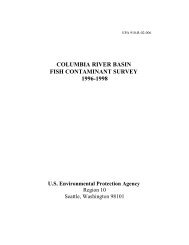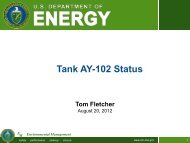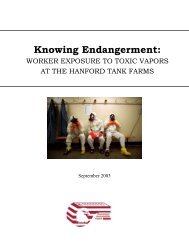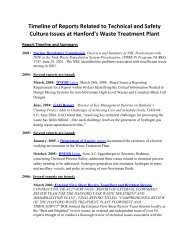Reducing the Risks of High-Level Radioactive Wastes at Hanford
Reducing the Risks of High-Level Radioactive Wastes at Hanford
Reducing the Risks of High-Level Radioactive Wastes at Hanford
Create successful ePaper yourself
Turn your PDF publications into a flip-book with our unique Google optimized e-Paper software.
64 Alvarez<br />
provision. After vigorous protest by Washington St<strong>at</strong>e’s US Sen<strong>at</strong>e Deleg<strong>at</strong>ion.<br />
Also, sludge from deterior<strong>at</strong>ed spent reactor fuel <strong>at</strong> <strong>the</strong> <strong>Hanford</strong> K-basins 116 and<br />
wastes from a dozen tanks 117 are design<strong>at</strong>ed as “potential transuranic wastes”<br />
for disposal in <strong>the</strong> DOE’s Waste Isol<strong>at</strong>ion Pilot Project (WIPP) in New Mexico.<br />
Attempts to dispose <strong>of</strong> <strong>Hanford</strong> HLW tank wastes implicitly raises <strong>the</strong> question:<br />
Will WIPP, by default, become <strong>the</strong> second repository for thousands <strong>of</strong> HLW<br />
canisters which DOE claims it has no room for in Yucca Mountain?<br />
Concurrent with <strong>the</strong> design and construction <strong>of</strong> tre<strong>at</strong>ment facilities, 40<br />
tanks are scheduled to be emptied and “interim” closed within <strong>the</strong> next two<br />
years. 118 Such tanks are expected to have all retrievable wastes removed and<br />
to be in a stable st<strong>at</strong>e for final closure. 119 Once wastes are removed, cement<br />
will be poured in <strong>the</strong> tanks to immobilize yet-to-be determined concentr<strong>at</strong>ions<br />
<strong>of</strong> residual long-lived radionuclides.<br />
The scientific underpinning for disposal decisions <strong>at</strong> <strong>Hanford</strong> should be<br />
a sound understanding <strong>of</strong> <strong>the</strong> f<strong>at</strong>e and transport <strong>of</strong> tank wastes in <strong>the</strong> environment.<br />
Even though a large amount <strong>of</strong> wastes were discharged or leaked<br />
into <strong>the</strong> soil, DOE’s current understanding <strong>of</strong> contaminant mobility “is inadequ<strong>at</strong>e<br />
to fully support cleanup, closure, or performance assessment-rel<strong>at</strong>ed<br />
decisions.” 120<br />
The closure <strong>of</strong> 177 large tanks and many miles <strong>of</strong> underground pipes and<br />
rel<strong>at</strong>ed infrastructure will leave behind significant amounts <strong>of</strong> residual highlevel<br />
wastes. According to DOE-sponsored research, radionuclides from tank<br />
closure represent “one <strong>of</strong> <strong>the</strong> most significant long-term dose contributors on<br />
site ...However, <strong>the</strong> radionuclide release r<strong>at</strong>e from <strong>the</strong>se solids is virtually<br />
unknown.” 121<br />
Under current regul<strong>at</strong>ions, <strong>the</strong> NRC still determines wh<strong>at</strong> constitutes highlevel<br />
wastes for geological disposal <strong>at</strong> <strong>Hanford</strong>. 122,123,124 However, NRC has chosen<br />
to exercise its authority through staff-level agreements with <strong>the</strong> DOE. NRC<br />
has yet to issue a formal determin<strong>at</strong>ion by rulemaking, or o<strong>the</strong>r means, regarding<br />
on-site disposal <strong>of</strong> defense high-level wastes. This regul<strong>at</strong>ory approach has<br />
allowed DOE to proceed with actions, such as disposal <strong>of</strong> HLW tank residuals<br />
<strong>at</strong> <strong>the</strong> Savannah River Site, which for all practical purposes are irreversible.<br />
It also, in <strong>the</strong> case <strong>of</strong> <strong>Hanford</strong>, allows DOE to disregard agreements with NRC<br />
staff, without regul<strong>at</strong>ory consequences.<br />
Given <strong>the</strong>se circumstances, <strong>the</strong> NRC staff provisionally agreed to a plan by<br />
DOE in 1997, to remove radionuclides from soluble high-level wastes to allow<br />
<strong>the</strong>ir on-site disposal. 125 This agreement was specifically based on estim<strong>at</strong>es<br />
provided by DOE th<strong>at</strong>:<br />
1. Radionuclide removal to <strong>the</strong> maximum extent technically and economically<br />
practical will leave no more than 9.8 MCi Cs-137(including barium-137 m<br />
decay product)and 6.8 MCi Sr-90 (including yttrium- 90 decay product) low<br />
activity wastes. 126







